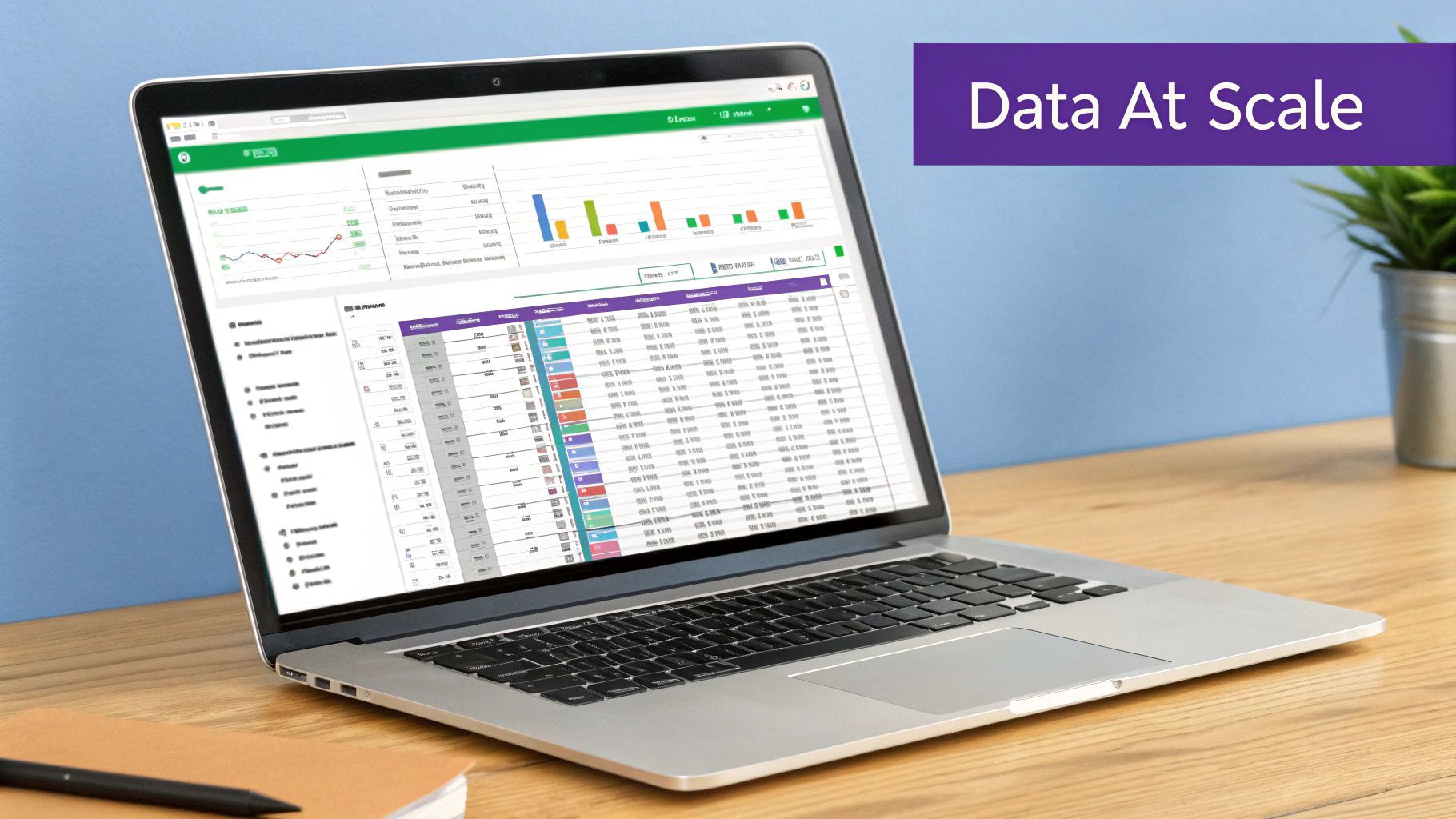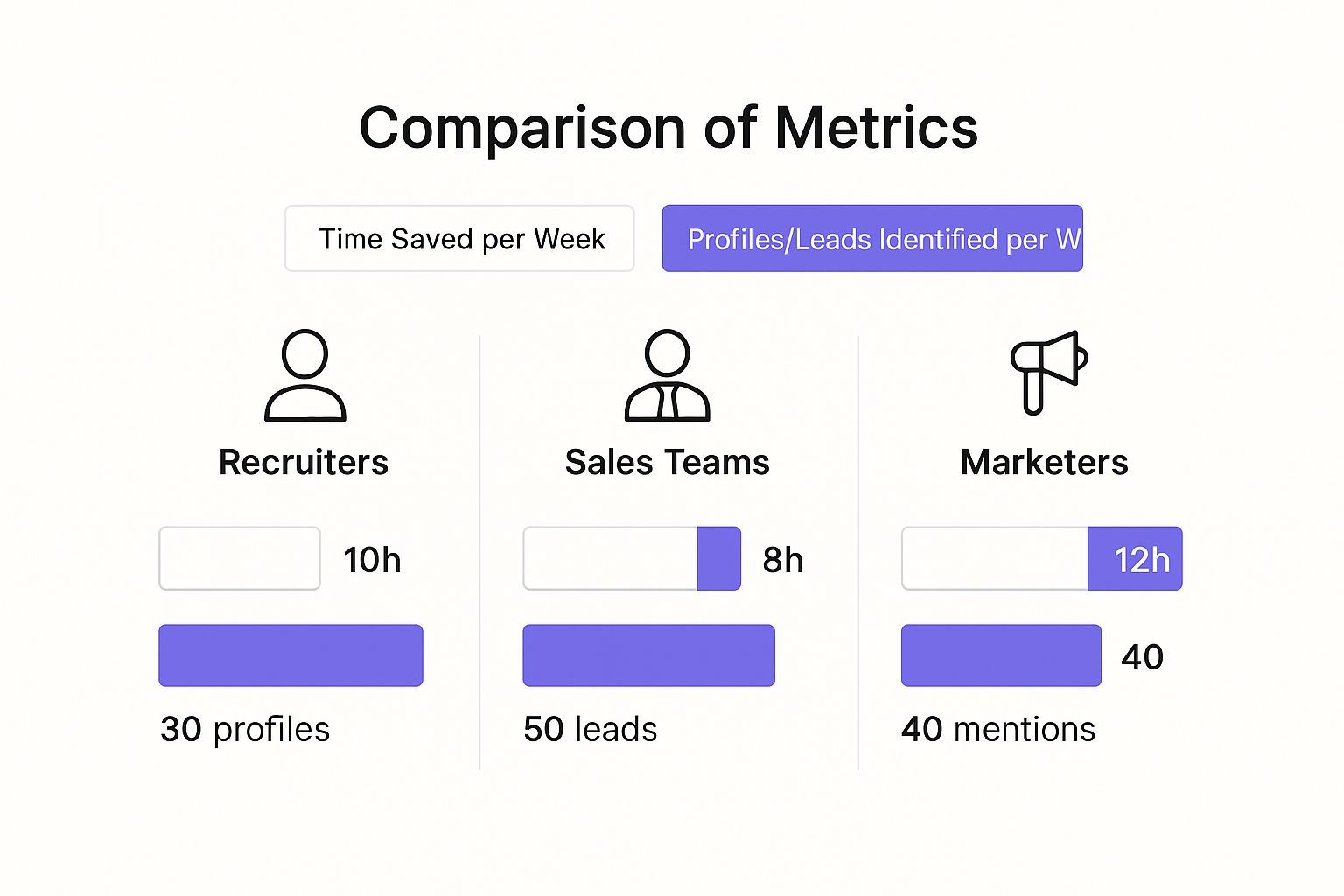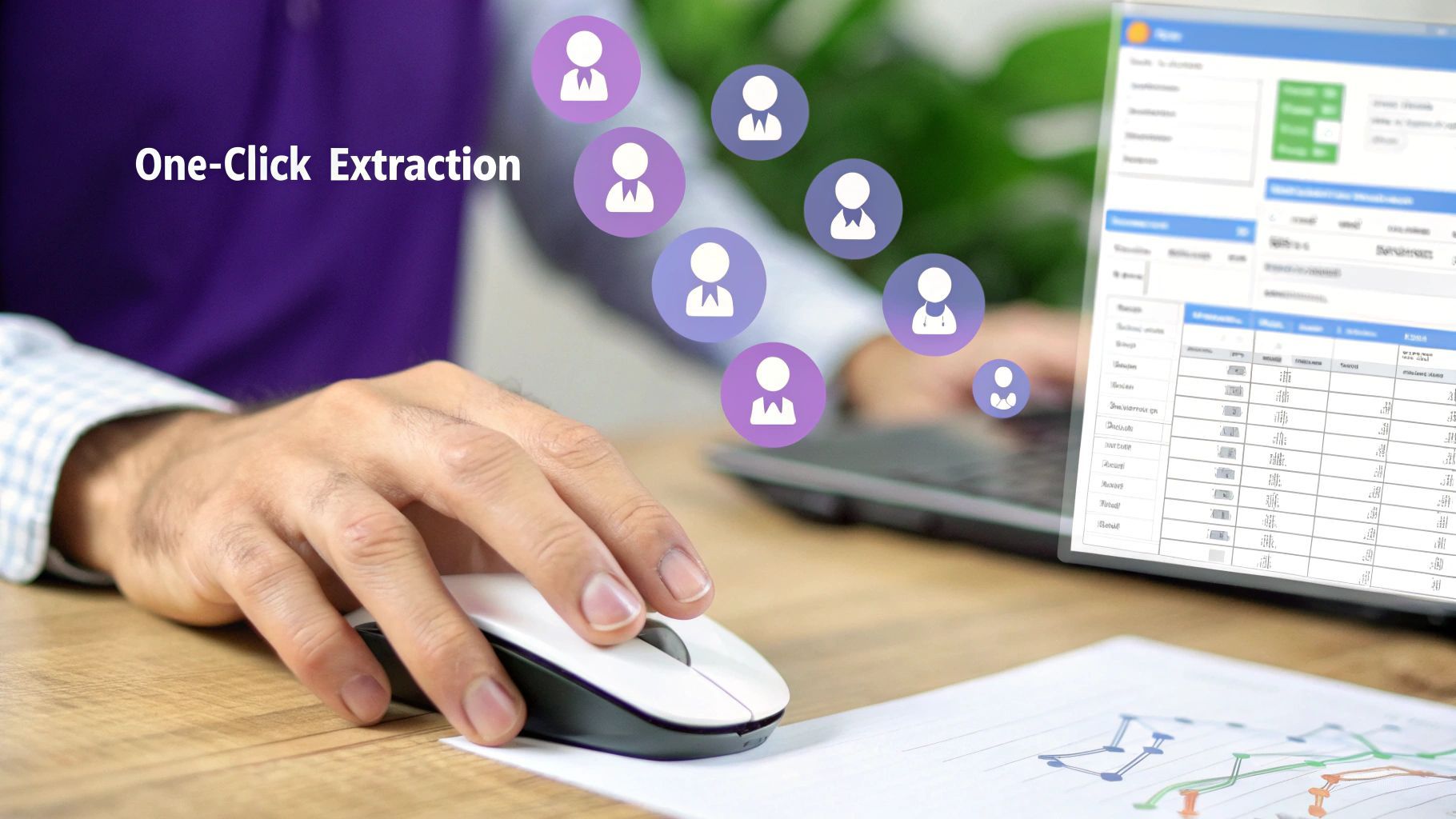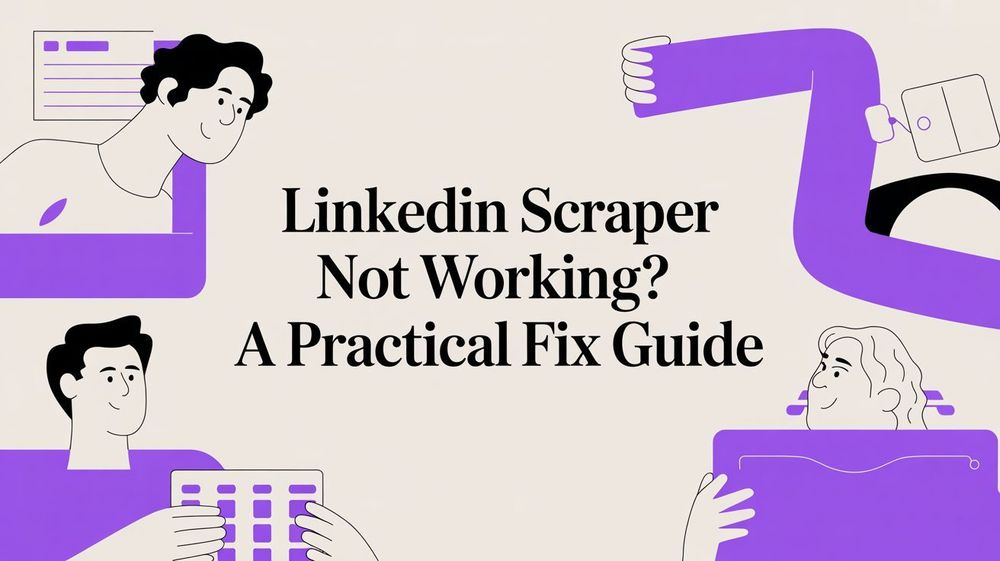At its core, social media scraping is the automated process of gathering public data from platforms like LinkedIn, Twitter, and Facebook. Imagine hiring a team of lightning-fast assistants to copy and paste public profile information into a neat spreadsheet. That's what a scraper does, but it saves you countless hours of mind-numbing manual work.
For any recruiter, sales professional, or marketer, this isn't just a time-saver; it's a strategic tool for gathering intelligence quickly and efficiently.
What Is Social Media Scraping and Why It Matters

Let's get practical. Say you're a recruiter who needs to find 50 qualified software engineers on LinkedIn. You could spend an entire day (or longer) manually clicking on profiles, copying names, job titles, and companies, and pasting everything into a spreadsheet. It’s slow, tedious, and full of potential for typos. It just doesn't scale.
Social media scraping automates that entire workflow. A specialized tool or script does the job, pulling specific information from hundreds—or even thousands—of public profiles in minutes. This raw data is then neatly structured into a usable format, like a CSV file, ready for you to analyze or import into your systems.
The Core Business Advantage
The point of social media scraping isn't just to hoard data—it's to turn public information into actionable business intelligence. For recruiters, sales teams, and marketers, this is a game-changer. You're transforming raw, publicly available info into tangible opportunities.
In fact, scraping is often the first step in a comprehensive social media analytics strategy, uncovering trends and insights that would otherwise stay hidden in plain sight.
Here's what that really means for your business:
- Speed and Scale: Gather huge amounts of data in a fraction of the time it would take a human.
- Efficiency: Free your team from soul-crushing data entry to focus on high-value work like outreach and strategy.
- Data-Driven Decisions: Build rich datasets to spot market trends, watch competitors, or create highly targeted lead lists.
- Comprehensive Insights: Collect a wide range of public details—from contact info to job titles and skills—to get the full picture.
In essence, social media scraping closes the gap between the ocean of public data online and your ability to use it. It converts chaotic, unstructured information into organized, strategic assets for your business.
Manual Collection vs. Automated Scraping
The difference between manually copying data and using an automated scraper is like sending letters by horse versus sending an email. One gets the job done eventually, but the other is exponentially faster, more reliable, and built for the modern world.
Manual collection is slow and limited. Automated scraping, on the other hand, operates at a scale that's impossible to match by hand. For any professional who needs to stay competitive, the ability to quickly build a candidate pipeline or a list of sales prospects is a massive advantage.
This is exactly where a no-code scraping tool becomes essential, putting all this power in your hands without needing a technical background.
Where Recruiters, Sales Pros, and Marketers Use Social Media Scraping

The real magic of social media scraping isn't the tech—it's the business problems it solves. For anyone whose job depends on finding the right people, it turns public data into real opportunities.
Recruiters, sales teams, and marketers live and die by speed and accuracy. Doing this stuff by hand is a total drag. It creates bottlenecks, eats up resources, and slows you down. Scraping automates the grunt work so you can focus on strategy and talking to people.
Modern tools like ProfileSpider make this ridiculously easy, turning hours of mind-numbing research into a single click. Here’s how it works in the real world.
For Recruiters: Supercharge Your Candidate Pipeline
Imagine your boss asks you to find five senior Java developers with fintech experience. The old way? You'd spend hours, maybe days, manually digging through LinkedIn, sifting through profiles, and copy-pasting names and job titles into a spreadsheet. It’s slow, boring, and you're bound to make mistakes.
With social media scraping, that workflow gets a massive upgrade. You can run a targeted search on LinkedIn, then use a one-click scraper like ProfileSpider to instantly pull the details of every candidate on the page into a clean, organized list.
- Smarter Sourcing: Quickly build a rich database of potential hires from LinkedIn, GitHub, or niche job boards.
- Talent Mapping: See who the top talent is at your competitors and build a proactive hiring pipeline.
- Data Enrichment: Get the full picture—skills, experience, contact details—to make your outreach personal and effective.
The result is a total flip in how you spend your time. Instead of spending 80% of your day on data entry and only 20% on outreach, you can reverse that. You end up connecting with more qualified candidates, faster than the competition.
For Sales Teams: Find Decision-Makers in a Flash
A salesperson needs to find the Head of Marketing at 50 different companies. Manually, that means visiting 50 websites, hunting for the "About Us" page, then hopping over to LinkedIn to find the right person and their contact info. It's a necessary evil of lead generation, but it's a grind.
A lead generation scraper changes everything. Just navigate to a company’s team page or a relevant LinkedIn search, and a tool like ProfileSpider can extract a clean list of names, titles, and social profiles in seconds. It’s all there, ready for your CRM.
This is also a great way for sales teams to run a fast people search across multiple platforms, giving them a 360-degree view of a prospect before making that first call. It speeds up the top of the sales funnel, freeing up more time for personalizing messages and building actual relationships.
For Marketers: Uncover Influencers and Track Brand Buzz
For marketers, staying on top of the conversation is everything. If you're launching a new product, you need to find micro-influencers and keep an eye on what people are saying about your brand. Trying to track hashtags on X (formerly Twitter) or search for mentions on Instagram by hand is like trying to drink from a firehose.
Social media scraping automates that intelligence gathering. Marketers can instantly see who is using certain hashtags, spot creators with great engagement, and track mentions of their brand across different platforms.
- Influencer Discovery: Find and vet potential collaborators by scraping profiles from Instagram, TikTok, or YouTube based on keywords and engagement stats.
- Brand Monitoring: Collect public posts mentioning your brand or competitors to analyze sentiment and jump on customer feedback.
- Audience Insights: Gather data on follower demographics and interests to sharpen your marketing personas and create content that connects.
Scraping gives marketers the hard data they need to make smart decisions, connect with the right people, and stay one step ahead of the market.
The Old Way vs. The New Way
Before simple, no-code scraping tools arrived, getting data from social media was a story of two painful extremes. You were either stuck with mind-numbingly slow manual work or forced to dive into the deep waters of custom coding. Both paths are littered with hurdles that drain time and money, pulling you away from what you're actually trying to do—find great leads or candidates.
The most basic method? Good old copy-and-paste. Picture a recruiter who’s found a list of potential candidates on LinkedIn. They'd spend hours painstakingly highlighting names, job titles, and company details, then pasting each bit of info into a spreadsheet. One. By. One. It’s brutally inefficient.
This approach is slow and a magnet for human error. A single slip of the mouse can mess up your data. But the biggest problem is that it just doesn't scale. Need to collect info from a few hundred profiles? That's not a task; it's a project that will completely derail your week.
The Pitfalls of Manual Data Collection
The real issue with doing things by hand is the massive bottleneck it creates. Every minute spent on tedious data entry is a minute you could have spent on high-value activities, like reaching out, running interviews, or closing deals.
- Extremely Inefficient: Manually pulling data from just 50 profiles can eat up hours, making any large-scale project a non-starter.
- High Error Rate: Repetitive copy-pasting is a recipe for typos, weird formatting, and incomplete records.
- No Scalability: The process can't grow with your business. If you want to double your lead target, you have to double your manual labor. It's a losing game.
This infographic drives home how much time is wasted—and how much opportunity is lost—when you stick to these outdated methods.

The numbers don't lie. Professionals can get back nearly a full day's work every week while also boosting their output. That's the direct result of leaving manual collection behind.
The Headaches of Custom Coding
The other old-school alternative was to build a custom scraper using a programming language like Python. While powerful, it’s a complete non-starter for most business professionals. It requires a different skillset, turning a simple lead generation task into a full-blown software development project.
The global web scraping market is on track to be worth anywhere from $2.2 to $3.5 billion by 2025. And a whopping 69.6% of developers prefer using Python for it. This shows how big the industry is, but it also screams, "This is technical!" If you want to dig into more stats, Scrapingdog.com has some great market research.
Even if you have the technical chops, the challenges are very real.
Building a scraper is one thing; keeping it running is another beast. Websites constantly change their layouts, and a small update can break your custom script overnight. That means you’re on the hook for ongoing technical maintenance just to keep the lights on.
Here are a few of the technical roadblocks you’d face:
- Steep Learning Curve: You need to be an expert in programming, HTML, and web protocols.
- Constant Maintenance: Scripts need to be updated constantly to keep up with website changes.
- Technical Roadblocks: Getting around IP blocks, CAPTCHAs, and dynamic content requires advanced solutions.
A Better Way to Scrape Social Media
The choice between these methods used to be a tough one. But now there’s a way to get speed and accuracy without the hassle. Let’s take a look at a side-by-side comparison of the three main approaches.
| Method | Effort Required | Technical Skill | Maintenance | Best For |
|---|---|---|---|---|
| Manual Scraping | High | None | N/A | Very small, one-off tasks (e.g., <10 profiles) |
| Custom Coding | High | Expert | High & Ongoing | Large, complex projects with a dedicated developer |
| No-Code Tools | Low | None | None | Sales, recruiters, and marketers needing fast, scalable data |
Both traditional methods create more problems than they solve for the average professional. They force you to choose between painfully slow manual labor and a costly, complex technical project. This huge gap is exactly what modern, no-code solutions like ProfileSpider were built to fill. It gives you a one-click workflow that gets the job done without any technical headaches.
The Modern Solution: No-Code, One-Click Scraping

There’s a huge gap between the slow grind of manual data entry and the complexity of building custom scraping scripts. That gap is where modern, smarter tools have emerged. Today's no-code scraping tools are built for business pros—people who need powerful data but don't have the time or technical background to become developers.
A new wave of tools, led by solutions like ProfileSpider, is turning social media scraping into a simple, one-click process. It’s no longer a developer’s game. The whole point is to hide the technical complexity so you can focus on what matters: finding leads, sourcing candidates, or getting a read on the market.
Instead of writing scripts or getting lost in spreadsheets, you just go to a page, click a button, and let the tool do the heavy lifting. This makes high-level data intelligence accessible to anyone.
How AI-Powered Extraction Actually Works
The magic behind this simplicity is AI-powered profile extraction. Think of it as a smart assistant in your browser. When you click to extract profiles, an AI engine instantly scans the page's code, identifies key info like names and job titles, and pulls it all into a structured list.
This AI-driven approach solves the biggest headaches of old-school scraping:
- Adapting to Website Changes: Social platforms like LinkedIn constantly tweak their layouts. A traditional scraper would break, but an AI-powered tool adapts on the fly, so your data collection never stops.
- Intelligent Data Parsing: It’s smart enough to know the difference between a name, a job title, and a company, capturing each field correctly without you having to configure anything.
- Single vs. Multi-Profile Detection: The tool instantly recognizes whether you're on a single profile or a list of search results. It adjusts automatically, scraping one profile or hundreds with the same click.
This enables a true one-click profile extraction experience. You get all the power of a custom-coded script, but you never have to see or write a line of code.
The goal of a modern scraper is to make the technology invisible. The user experience should be as simple as pointing to the data you want and having it appear in a clean, organized list, ready for you to use.
Universal Compatibility Across Any Website
One of the biggest wins for no-code tools like ProfileSpider is their universal compatibility. Traditional scrapers often had to be built for one specific site. Modern tools are designed to work anywhere you find profile data.
This isn’t just for big names like LinkedIn or X (formerly Twitter). The universal engine can pull clean data from:
- Niche industry forums and communities
- Company "About Us" or team pages
- Event attendee and speaker lists
- Specialized job boards and talent directories
Since there's zero setup or configuration, you can jump from one site to another, grabbing data with the same simple click. That flexibility is a game-changer for anyone sourcing leads or candidates from multiple online sources. You can learn more about how to use an instant data scraper for these tasks in our detailed guide.
The Business Impact of Accessibility
The rise of these tools isn't just a tech trend; it's a business one. Companies are relying more on web scraping, with about 65% of global enterprises using data extraction for competitive intelligence. The e-commerce world is especially hungry for this data, with nearly 48% of deployments aimed at tracking competitors and gauging consumer sentiment on social media.
This shows that access to scraped data isn't a "nice-to-have" anymore—it's essential for staying competitive.
No-code tools level the playing field. Suddenly, a solo recruiter or a small sales team can gather the same quality of intelligence as a large corporation with a dedicated data science team. This accessibility empowers anyone to make smarter, data-backed decisions that directly grow their business.
Navigating Privacy and Compliance Responsibly
The power of social media scraping comes with responsibility. When you automate data collection, you have to play within ethical and legal lines. The number one rule is simple: only scrape publicly available data. This means information a platform intends for people to see—the stuff that's open to any visitor, not locked behind a login or private account.
Ignoring this principle isn't just about breaking trust; it can land you in murky legal waters. Scraping responsibly means respecting both user privacy and the rules of the platforms you're on. This is where a solid understanding of privacy regulations and how your tools handle data becomes essential.
Understanding the Rules of the Road
Staying compliant boils down to two main things: the platform's own rules and broader data privacy laws.
- Terms of Service (ToS): Every social media site has a ToS document that spells out what you can and can't do. Violating those terms can risk getting your account suspended or blocked.
- Data Privacy Regulations: Laws like the General Data Protection Regulation (GDPR) in Europe have set strict rules for handling personal data. Even if you're not based in the EU, if you're collecting info on EU citizens, those rules can still apply. You can dive deeper into the complexities in our guide to website scraping legality.
Why Local Data Storage Is a Game Changer for Compliance
This is where the design of your scraping tool really matters. Many tools process your data on their own servers, which immediately creates a potential compliance headache. The moment that data leaves your machine, you’ve lost direct control.
A privacy-first approach flips this script. By storing all extracted data locally on your computer, you maintain 100% control and ownership. The data never touches an external server unless you explicitly say so.
This is exactly how ProfileSpider was built. It uses your browser's own IndexedDB storage—a secure, private database that lives right on your device and nowhere else.
This local-first model gives you major advantages for managing data responsibly:
- Complete Data Control: You are the sole keeper of the information you collect. You decide how it’s stored, used, and when it gets deleted.
- Enhanced Privacy: Since no profile data is sent to third-party servers, the risk of an external data breach is virtually eliminated.
- GDPR and CCPA Alignment: Storing data locally helps you stay in line with core principles of modern privacy laws, like data minimization and purpose limitation.
Whenever you're considering a data scraping service, it's crucial to review a service provider's privacy policy to ensure they're handling data ethically. A transparent policy is a great sign of a company’s commitment to your security. By choosing a tool that puts local storage first, you’re not just getting a powerful scraper—you're building a compliant and secure workflow.
FAQ
Even with the best tools, it's natural to have questions about the nuts and bolts of social media scraping. Getting straight answers on the process, the rules, and the practical side of things turns a powerful tool into a real asset.
Let's tackle some of the most common questions from recruiters, sales pros, and marketers.
Is Social Media Scraping Legal?
This is always the first question, and for good reason. The short answer? Yes, scraping publicly available data is generally legal. While it's a nuanced topic, major court rulings have consistently sided with the idea that if information is available for anyone to see on the public internet—no login or password needed—it's fair game to collect.
But legal doesn’t mean it’s a free-for-all. Being responsible is key:
- Public Data Only: Never try to scrape data from private profiles or anything behind a login wall. Ethical scraping is about what's been shared openly.
- Be a Good Neighbor: A good scraper doesn't slam a website's servers with a flood of requests, which can slow things down for everyone.
- Know the Terms of Service: While the law is on your side for public data, being aware of a platform's Terms of Service (ToS) helps you avoid any hiccups with your account on that specific site.
The bottom line is this: automatically collecting data isn't the issue. It comes down to what data you’re collecting and how you’re doing it. Tools like ProfileSpider are built for responsible collection. They stick to public info and run locally in your browser, so you're always in control.
When you stick to public data and use a well-designed tool, you can gather the intelligence you need without crossing legal or ethical lines.
Do I Need to Be a Developer to Scrape Social Media?
This is a common myth from how scraping used to be done. For a long time, you had to write code, usually in a language like Python. It was a technical minefield that locked out most business professionals.
Thankfully, those days are over. Today, the answer is a firm no, you absolutely do not need to be a developer.
The rise of no-code tools has completely changed the game. Now, powerful social media scraping technology is accessible to anyone who needs it. Solutions like ProfileSpider are built specifically for recruiters, marketers, and sales teams—people who need results, not a coding project.
These tools do all the heavy lifting for you:
- AI figures out where the profile data is and pulls it automatically.
- The software adapts on its own when a website changes its layout.
- The entire process is boiled down to a simple, one-click interface.
Instead of fighting with code, you can pull complete, organized profiles from almost any website. This shift lets you focus on your real job—finding that perfect candidate or your next big sales lead.
How Can I Manage the Data I Collect?
Getting the data is just step one. The real magic happens when you can manage and use that information. Dumping a bunch of names into a messy spreadsheet isn't saving time; it's creating a new headache. That's why modern scraping tools are built with robust organization features, turning them into a simple data hub.
The goal is to keep every profile you collect organized, searchable, and ready to go. With a tool like ProfileSpider, you’re not just extracting data—you’re gaining a suite of features designed to fit your workflow.
Here’s how you can keep your data under control:
- Create Custom Lists: Group profiles by project or campaign. A recruiter might create lists like "Senior Java Candidates Q4" or "Potential Marketing Hires."
- Tag and Filter: Add custom tags to profiles to get granular. You could tag candidates by skill ("JavaScript," "AWS") or leads by status ("Initial Contact," "Follow-Up Required"). Then, you can instantly search and find exactly who you need.
- Export with Ease: Move your data wherever it needs to be. You can export your lists to CSV, JSON, or Excel, and even customize the fields to perfectly match the import requirements for your CRM or Applicant Tracking System (ATS).
This level of organization ensures the data you collect becomes a strategic asset, not just a cluttered archive. It lets you build clean, targeted databases for sourcing talent, generating leads, or researching your market, making social media scraping a seamless part of your business.




